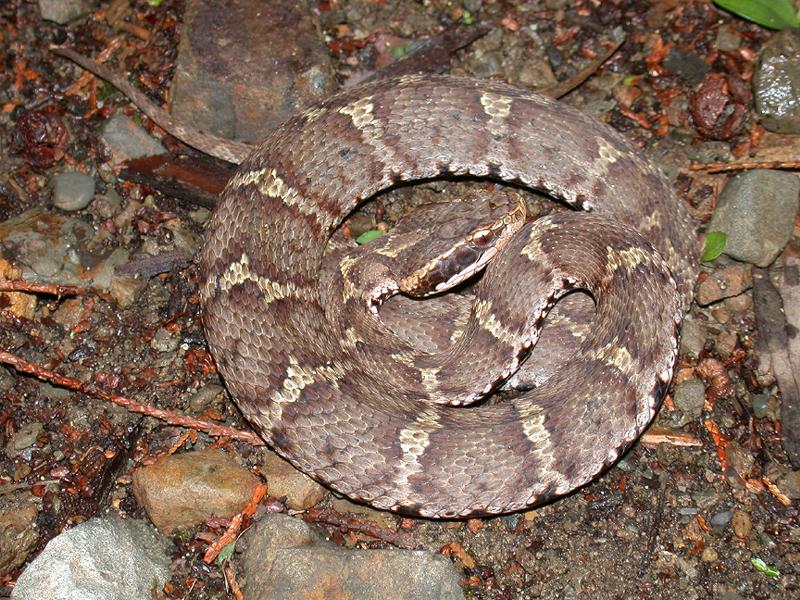- Gloydius blomhoffii
Taxobox
name = "Gloydius blomhoffii"

regnum =Animal ia
phylum = Chordata
subphylum = Vertebrata
classis = Reptilia
ordo =Squamata
subordo =Serpentes
familia =Viperidae
subfamilia =Crotalinae
genus = "Gloydius "
species = "G. blomhoffii"
binomial = "Gloydius blomhoffii"
binomial_authority = (Boie, 1826)
synonyms = * "Trigonocephalus Blomhoffii" - H. Boie, 1826
* "Trigonocephalus" [("Halys")] "affnis" - Gray, 1849
* "Trigonocephalus" [("Halys")] "Blomhoffii" - Gray, 1849
* "T" ["rigonocephalus"] . "Blomhoffii" var. "megaspilus" - Cope, 1860
* "Halys blomhoffii" - Peters, 1862
* "T" ["rigonocephalus"] . "blomhoffii" - Jan, 1963
* "Ancistrodon blomhoffii" - Boulenger, 1896
* "Agkistrodon blomhoffii" ? "affinis" - Stejneger, 1907
* "Ancistrodon halys blomhoffii" - Nikolsky, 1916
* "Agkistrodon blomhoffii blomhoffii" - Sternfeld, 1916
* "A" ["ncistrodon"] . "blomhoffii blomhoffii" - Werner, 1922
* "Agkistrodon blomhoffii affinis" - Werner, 1922
* "Ankistrodon halys blomhoffii" - Pavloff, 1926
* "Agkistrodon halys blomhoffii" - Mell, 1929
* "Agkistrodon halys affinis" - Mell, 1929
* "Gloydius blomhoffi blomhoffi" - Hoge & Romano-Hoge, 1981
* "Agkistrodon affinis" - Gloyd & Conant, 1990McDiarmid RW, Campbell JA, Touré T. 1999. Snake Species of the World: A Taxonomic and Geographic Reference, vol. 1. Herpetologists' League. 511 pp. ISBN 1-893777-00-6 (series). ISBN 1-893777-01-4 (volume).]:"Common names: mamushi,Mehrtens JM. 1987. Living Snakes of the World in Color. New York: Sterling Publishers. 480 pp. ISBN 0-8069-6460-X.] Japanese mamushi.Gumprecht A, Tillack F, Orlov NL, Captain A, Ryabov S. 2004. Asian Pitvipers. GeitjeBooks Berlin. 1st Edition. 368 pp. ISBN 3-937975-00-4.] ""Gloydius blomhoffii" is a venomous pitviper
species found inChina ,Korea andJapan . Foursubspecies are currently recognized, including the nominate subspecies described here.ITIS|ID=634884|taxon=Gloydius blomhoffii|year=2007|date=19 May]Description
This species grows to a length of up to 91 cm, although the average length is 45-61 cm.
The color pattern consists of a pale gray, reddish-brown or yellow-brown ground color, overlaid with a series of irregularly shaped lateral blotches. These blotches are bordered with black and often have lighter centers. The head is dark brown or black in color with beige or pale gray sides.
Common names
Mamushi, Japanese mamushi. In Japan it is commonly called the nihongo|"Japanese mamushi"|にほんマムシ|nihon mamushi, or just nihongo|"mamushi"|マムシ|. In Korea, it is known as 살무사 (salmusa).
Geographic range
Found in
China ,Korea andJapan . According to Gloyd and Conant (1990), there is no evidence to support claims that this species occurs in theRyukyu Islands . The type locality given is "Japan."Habitat
Occurs in a range of habitats, including swamps, marshes, meadows, open woodland, rocky hillsides and
montane rock outcroppings.Feeding
They hunt for birds and small rodents. Often found in and around farmland due to the associated rodent populations.
ubspecies
Taxonomy
Gloyd and Conant (1990) recognized five subspecies: the four mentioned in the table above, plus "A. b. ussuriensis", which is found in
Russia . However, Toriba (1986) elevated this fifth form to a species: "Gloydius ussuriensis ".This species is similar the cottonmouths and copperheads ("
Agkistrodon sp.") of the Americas and was long considered part of the same group (see synonymy).ee also
*
List of crotaline species and subspecies
*
*
*Snakebite References
Further reading
* Fukuda T, Iwaki M, Hong SH, Oh HJ, Wei Z, Morokuma K, Ohkuma K, Dianliang L, Arakawa Y, Takahashi M. 2005. Standardization of Regional Reference for Mamushi ("Gloydius blomhoffii") Antivenom in Japan, Korea and China. Japanese Journal of Infectious Diseases, 59, 20-24. [http://www.nih.go.jp/JJID/59/20.pdf PDF] at the [http://www.nih.go.jp/ Japanese Ministry of Health, Labour and Welfare] . Accessed18 December 2007 .External links
*
* [http://homepage3.nifty.com/japrep/snake/kusarihebi/text/ejapmamusi.htm "Gloydius blomhoffii"] at the [http://homepage3.nifty.com/japrep/englishtop.htm Encyclopedia of Japanese Reptiles] . Accessed20 December 2007 .
Wikimedia Foundation. 2010.
